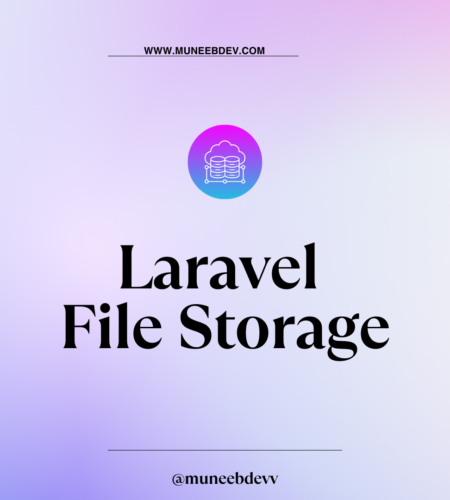Laravel, a PHP framework known for its elegant and expressive syntax, simplifies numerous tasks for developers, including file storage. Laravel’s file storage system is built on top of Flysystem, a file abstraction library, providing a unified API for interacting with various storage solutions such as local disks, Amazon S3, and even FTP/SFTP. This in-depth guide will explore the key aspects of Laravel’s file storage system, including configuration, file operations, and advanced features, while integrating important concepts such as laravel storage path, laravel storage file name, and more.
1. Introduction to Laravel File Storage
Laravel’s file storage system allows developers to store, retrieve, and manage files across different storage systems without changing the underlying code. This flexibility is made possible by Laravel’s integration with Flysystem, which supports various storage drivers.
2. Configuring the Filesystem
Laravel’s file storage configuration is managed in the config/filesystems.php file. This file defines multiple “disks,” each representing a storage driver and its configuration. Whether you need to store files locally or on cloud services like Amazon S3, Laravel makes the process seamless.
'disks' => [
'local' => [
'driver' => 'local',
'root' => storage_path('app'),
],
'public' => [
'driver' => 'local',
'root' => storage_path('app/public'),
'url' => env('APP_URL').'/storage',
'visibility' => 'public',
],
's3' => [
'driver' => 's3',
'key' => env('AWS_ACCESS_KEY_ID'),
'secret' => env('AWS_SECRET_ACCESS_KEY'),
'region' => env('AWS_DEFAULT_REGION'),
'bucket' => env('AWS_BUCKET'),
'url' => env('AWS_URL'),
'endpoint' => env('AWS_ENDPOINT'),
],
],
Key Concepts:
- Laravel Storage Path: The laravel storage path refers to the directory where files are stored, typically configured using the
storage_path()helper. This ensures that files are stored within thestorage/appdirectory by default. - Laravel Storage File Name: The laravel storage file name is the specific name given to a file when it is stored. Laravel can automatically generate a unique file name, or you can specify one manually.
3. Working with Files on Disks
Laravel provides a simple API to interact with your configured disks. Here’s how you can perform common file operations using Laravel’s storage system.
Creating and Storing Files:
To create and store a file, use the put method. You can specify the disk and the laravel storage file name:
Storage::disk('local')->put('example.txt', 'File contents');If you omit the disk, Laravel uses the default disk (usually local):
Storage::put('example.txt', 'File contents');Retrieving Files:
To retrieve a file’s contents, use the laravel storage disk get file method:
$contents = Storage::disk('local')->get('example.txt');You can also retrieve the file extension using the laravel storage get file extension method:
$extension = Storage::disk('local')->extension('example.txt');File Existence:
Check if a file exists using:
if (Storage::disk('local')->exists('example.txt')) {
// The file exists
}File URLs:
For public disks, you can generate URLs using:
$url = Storage::url('example.txt');This is especially useful for serving files stored publicly.
4. Advanced File Operations
Laravel’s file storage system is powerful and supports various advanced operations.
Temporary URLs:
Generate temporary URLs that expire after a set time, useful for secure sharing:
$url = Storage::temporaryUrl('file.jpg', now()->addMinutes(5));File Visibility:
Set the visibility of files to public or private:
Storage::put('file.jpg', 'Contents', 'public');Streaming Files:
For large files, use putFile or putFileAs to manage file streams efficiently:
$path = Storage::putFile('photos', new File('/path/to/photo'));File Metadata:
Retrieve file metadata like size and MIME type:
$size = Storage::size('file.jpg');
$mime = Storage::mimeType('file.jpg');Renaming Files:
Use the laravel storage rename file method to rename or move files within a disk:
Storage::move('old/file.jpg', 'new/file.jpg');Deleting Files:
To delete a file from storage, especially from the public disk, use the laravel delete file from storage public method:
Storage::disk('public')->delete('file.jpg');5. Handling Directories
Laravel also provides robust directory management capabilities.
Creating and Deleting Directories:
Create a directory with makeDirectory and delete it using deleteDirectory:
Storage::makeDirectory('new-directory');
Storage::deleteDirectory('old-directory');Listing Files and Directories:
Retrieve lists of files and directories:
$files = Storage::files('directory');
$allFiles = Storage::allFiles('directory');
$directories = Storage::directories('directory');
$allDirectories = Storage::allDirectories('directory');These methods are particularly useful for managing large numbers of files.
6. Custom Filesystems and Drivers
Laravel’s file storage system is highly extensible, allowing you to create custom filesystem drivers. For example, to integrate with Dropbox, you would install a Flysystem adapter and register it in a service provider:
composer require spatie/flysystem-dropboxIn your service provider:
Storage::extend('dropbox', function ($app, $config) {
$client = new DropboxClient($config['authorization_token']);
$adapter = new DropboxAdapter($client);
return new FilesystemAdapter(
new Filesystem($adapter, $config),
$adapter,
$config
);
});You can then configure and use the Dropbox disk like any other disk.
7. Testing File Storage
Testing file storage in Laravel is straightforward with fake disks. This feature is useful for testing file uploads without affecting real files:
Storage::fake('photos');
UploadedFile::fake()->image('photo.jpg')->store('photos');
Storage::disk('photos')->assertExists('photo.jpg');With fake disks, you can simulate storage scenarios and ensure that your application behaves as expected.
8. Downloading Files
To download a file from storage, Laravel provides a simple API:
return Storage::download('file.jpg');This allows users to download files stored in your application easily.
9. Conclusion
Laravel’s file storage system is a powerful and flexible tool that can handle a wide range of use cases, from simple local file storage to complex cloud storage solutions. By mastering Laravel’s file storage capabilities, including understanding how to use laravel storage path, laravel storage file name, and other advanced features, you can build applications that efficiently manage files and directories, providing a seamless experience for both developers and users.
For further reading and specific code examples, refer to the Laravel documentation. This resource will provide you with the most up-to-date and comprehensive information available.


Comments